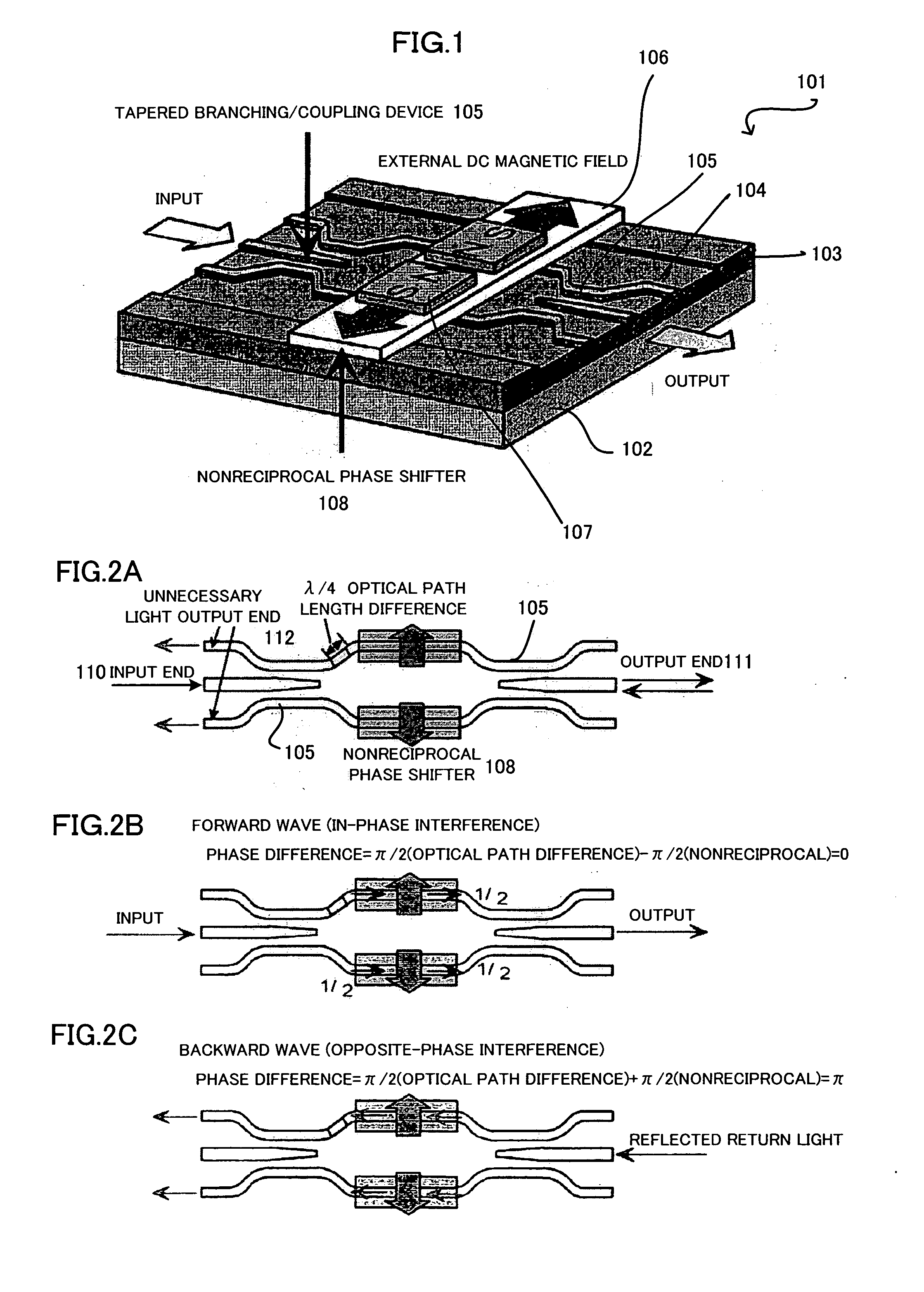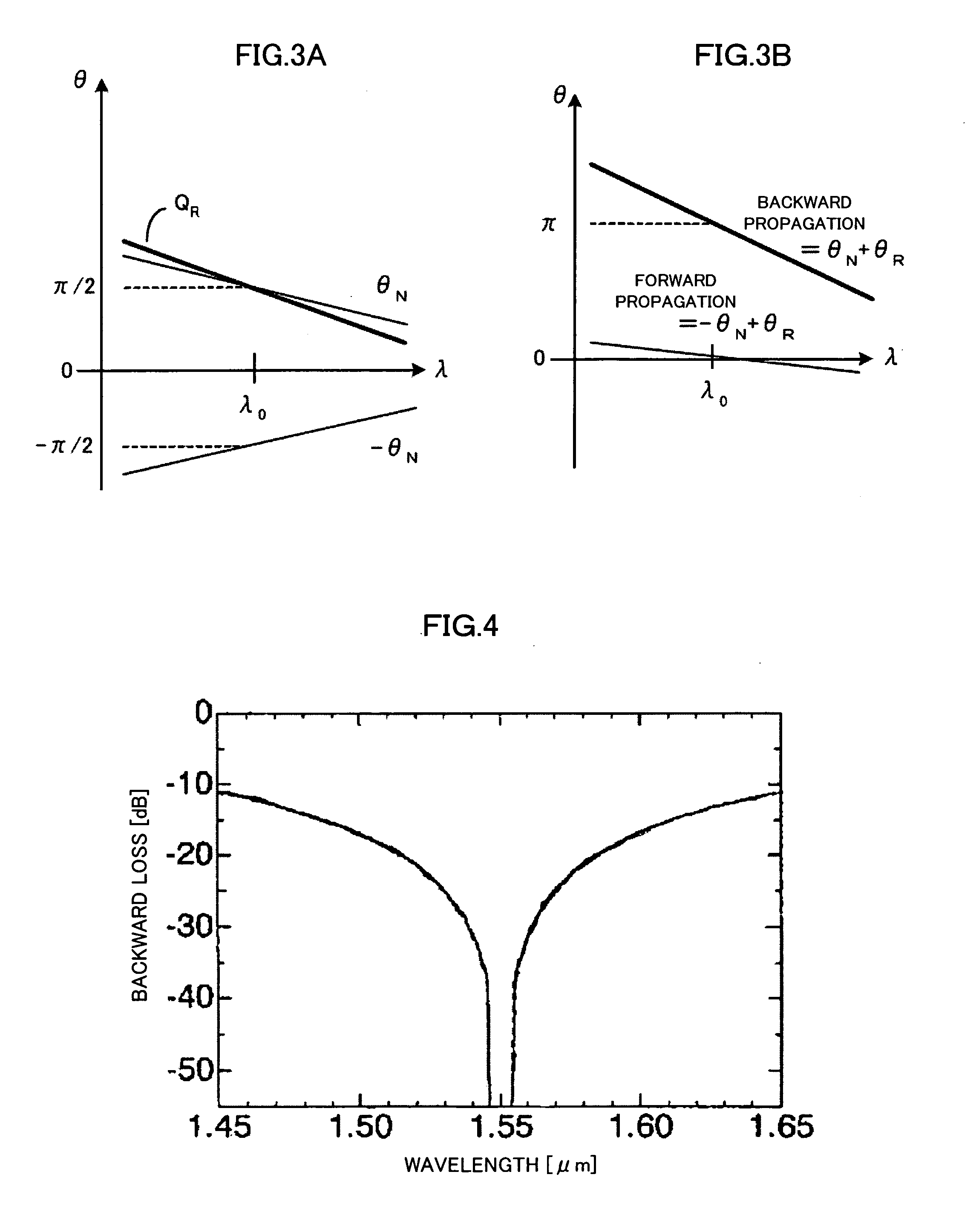Waveguide-Type Broadband Optical Isolator
- Summary
- Abstract
- Description
- Claims
- Application Information
AI Technical Summary
Benefits of technology
Problems solved by technology
Method used
Image
Examples
embodiment-1
[0086]Band broadening in a waveguide-type optical isolator having a waveguide layer comprising the magneto-optical material Ce:YIG (CeY2Fe5O12) shown in FIG. 19 will now be described as Embodiment-1.
[0087]Since “Ce:YIG” is the magneto-optical material, the wavelength-dependence of the Faraday rotation coefficient of “Ce:YIG” must be considered. For the wavelength-dependence of the Faraday rotation coefficient of “Ce:YIG”, “Ce:YIG” having the values shown in FIG. 11 is used. Further, for the wavelength-dependence of the refractive index of “Ce:YIG”, “Ce:YIG” having the values shown in FIG. 12 is used. On the basis of these values, a waveguide-type optical isolator having a waveguide layer comprising “Ce:YIG” is considered.
[0088]The layer structure of the waveguide is air (upper clad) / Ce:YIG (waveguide layer) / NOG (lower clad). In order to minimize the wavelength-dependence of the backward propagating waves, the reciprocal phase shifter 6 shown in FIG. 9 is formed in which L1=10.0 [μm]...
embodiment-2
[0091]Band broadening in a waveguide-type optical isolator having a waveguide layer comprising “Si”, as shown in FIG. 22, will now be described as Embodiment-2.
[0092]The layer structure of the present waveguide-type optical isolator is Ce:YIG (upper clad) / Si (waveguide layer) / SiO2 (lower clad layer). For the wavelength-dependence of the Faraday rotation coefficient of the upper clad Ce:YIG, “Ce:YIG” having the above-described value using FIG. 11 is used, for the wavelength-dependence of the refractive index of the waveguide layer Si, “Si” having a value shown in FIG. 23 is used, and for the wavelength-dependence of the refractive index of the substrate SiO2, “SiO2” having a value shown in FIG. 16 is used. The present waveguide-type optical isolator is an example of an ultra-small optical isolator formed from an SOI-wafer (Si / SiO2 / Si), and is used as an optical isolator for use in silicon-photonics optical circuits. In FIG. 22, although a multimode interference coupling device (an MM...
embodiment-3
[0096]A characteristic of a waveguide-type broadband optical isolator having a central wavelength of 1.55 [μm] is shown. The waveguide structure of which is shown in FIG. 14, in which L1=900 [μm], L2=899.55 [μm], W1=2.4 [μm], W2=2.0 [μm] and Lt=10 [μm]. The wavelength-dependence of the loss of a light wave entering the waveguide-type optical isolator obtained by the above design is shown in FIG. 26. The loss amount for the backward propagating waves is indicated by a solid line, while the loss amount for the forward propagating waves is indicated by a broken line. Over the wavelengths in the range of 1.4 [μm] to 1.65 [μm], the backward loss remarkably exceeds 30 [dB], which is a value conventionally required. As the deviation of the wavelength of incident light from 1.55 [μm] increases, the forward loss increases, but the wavelength-dependence of an isolation ratio defined by “backward loss−forward loss” is approximately determined by the wavelength-dependence of the backward loss, ...
PUM
 Login to View More
Login to View More Abstract
Description
Claims
Application Information
 Login to View More
Login to View More - R&D
- Intellectual Property
- Life Sciences
- Materials
- Tech Scout
- Unparalleled Data Quality
- Higher Quality Content
- 60% Fewer Hallucinations
Browse by: Latest US Patents, China's latest patents, Technical Efficacy Thesaurus, Application Domain, Technology Topic, Popular Technical Reports.
© 2025 PatSnap. All rights reserved.Legal|Privacy policy|Modern Slavery Act Transparency Statement|Sitemap|About US| Contact US: help@patsnap.com



